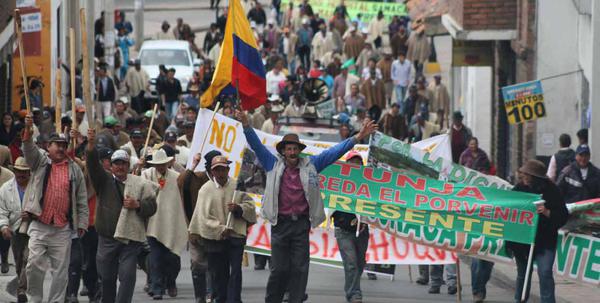After three tense weeks, Colombia´s rural national strike continues with no white smoke on the horizon. To contain the spreading crisis, the government of Juan Manuel Santos, under pressure from peasant strikers who have blocked several crucial highways, has followed a three-pronged strategy that has thus far proved ineffective.
One government tactic has been to negotiate separately with different peasant groups in an attempt to divide the movement by coopting some and coercing others without addressing the root causes of the conflict.
Second, Santos is shuffling some of the key figures in his cabinet such as the ministers of interior, agriculture and mining. However, these changes have been perceived to be nothing but window dressing. The newly appointed ministers have not been seen to be any more open than the ones they replaced to exploring serious alternatives to the socio-economic-environmental dislocation created by the rentier-extractive-biofuel model embraced by Santos´s government.
A case in point is the new appointed minister of agriculture, Rubén Darío Lizarralde, who was the manager of Indupalma, one of the largest private African palm oil agribusinesses in the country. This appointment alongside the retention of Mauricio Cárdenas—who is the “guru” of the rentier-model—as minister of the economy, demonstrates a lack of appreciation of the rural crisis, and beyond that, an acknowledgement of the nature of the class coalition that is determining economic policy: a class coalition that includes those associated with finance capital, large agribusiness, and the extractive sectors, all of which are tied in with global capital. The countervailing class forces that are currently facing off against the ruling coalition include small and middle-size land owners, mineworkers, small artisan miners, segments of the urban petty bourgeoisie and the inhabitants of the misery belt in Bogotá.

The third prong of his strategy has been the selective use of violence. Santos´s government has unleashed the coercive apparatus of the state (military, police and intelligence services), killing more than 14 people, injuring hundreds more and detaining scores of protesters. Santos and his associates are yet to realize that this crisis is structural and that its resolution will require sacrifices that might affect the class interests of his coalition. In other words, the ruling coalition must weigh the socioeconomic and political costs of suppressing the popular uprising versus finding a compromise in which the class interests of the contending forces are preserved at less than their desired optimal. Here lies the conflict dynamic at the moment of this writing.
Until then, the struggle will continue.
Stay tuned.
Nazih Richani is the Director of Latin American studies at Kean University. He blogs at nacla.org/blog/cuadernos-colombianos.

